The Grand-parents of George Alfred JOHNSON
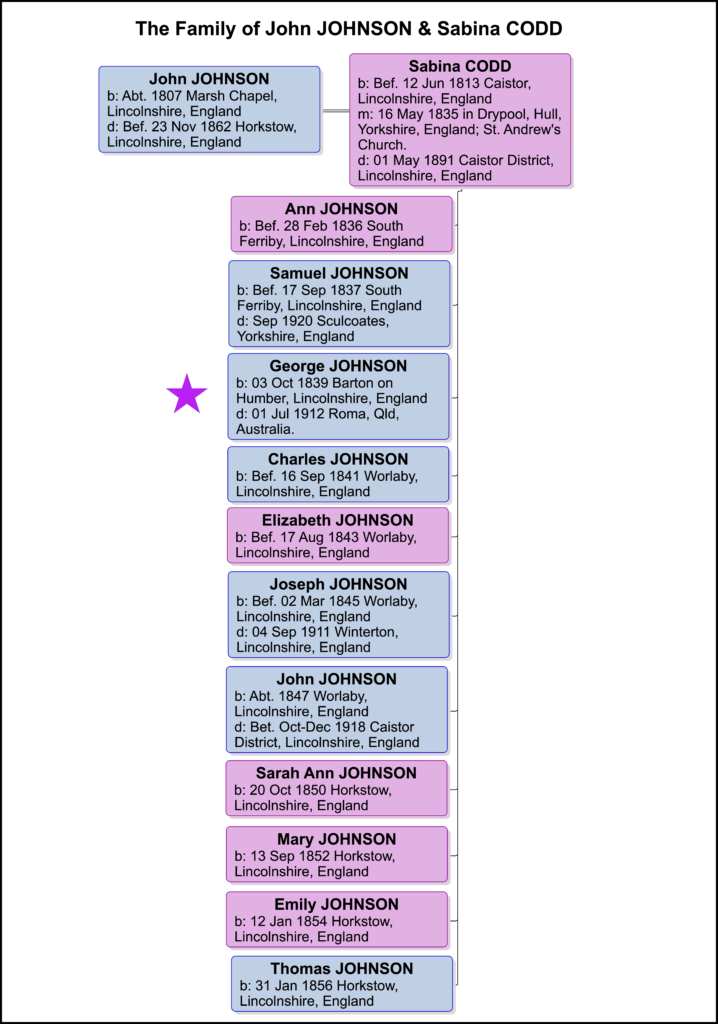
John JOHNSON
About eight kilometres from the English channel near the entrance to the Humber river lay the small village of Marsh Chapel, with a population of 354 people in 1801. This area of the coastland was known for its marshes. Salt was the chief industry from pre-Roman times until the 16th century. Marsh Chapel probably grew from a small hamlet of shepherds huts built for the summer pastures by the sea. By the mid-sixteenth century, it had fifty-five families with its main street, running north to south being called ‘Seadyke Way’, suggesting it represented the extremity of dry land. Seadyke way later became the High Street as the coastal marshes were drained and the population grew with more pastureland.
Little in known about the childhood of John Johnson or his parents Thomas and Ann. As you can imagine, there were many men with the name Thomas Johnson in Lincolnshire around the late 1780’s to 1800’s. We do know that John was born in about 1806-07 in Marshchapel, Lincolnshire. He was christened on the 29 January, 1807 in the local church – St. Mary’s Church of England 1.

St. Mary’s was a large church for a small town and became known, and is still known to-day, as ‘The Cathedral of the Marshes’. It was built in the early 15th century in the ‘perpendicular’ style. This meant the church was built in one piece rather than building a small nave and then adding the wings and bell tower over the centuries. It has three large bells.
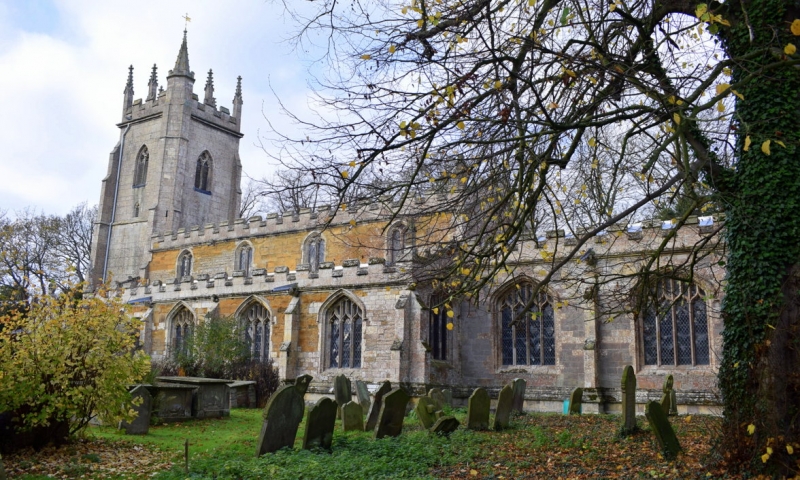
A ‘perpendicular’ church was built during the later stage of English Gothic church architecture, prevalent from the late 14th to mid 16th centuries and characterised by broad arches, elaborate fan vaulting, and large windows with vertical tracery.
As a point of interest: it is mentioned that the Old Hall at Marshchapel was built in 1720, on land which belonged to Sir Joseph Banks, explorer and naturalist, who accompanied Captain Cook to Australia3.
Sabina CODD
Sabina was the daughter of Samuel Codd and Martha Rhodes and was born about 1813 in Caistor, Lincolnshire and was christened on 12 June, 1813 at All Hallows’ Church of England, Clixby . Clixby is a small village about three kilometres north from the town of Caistor, in the Lincolnshire wolds.
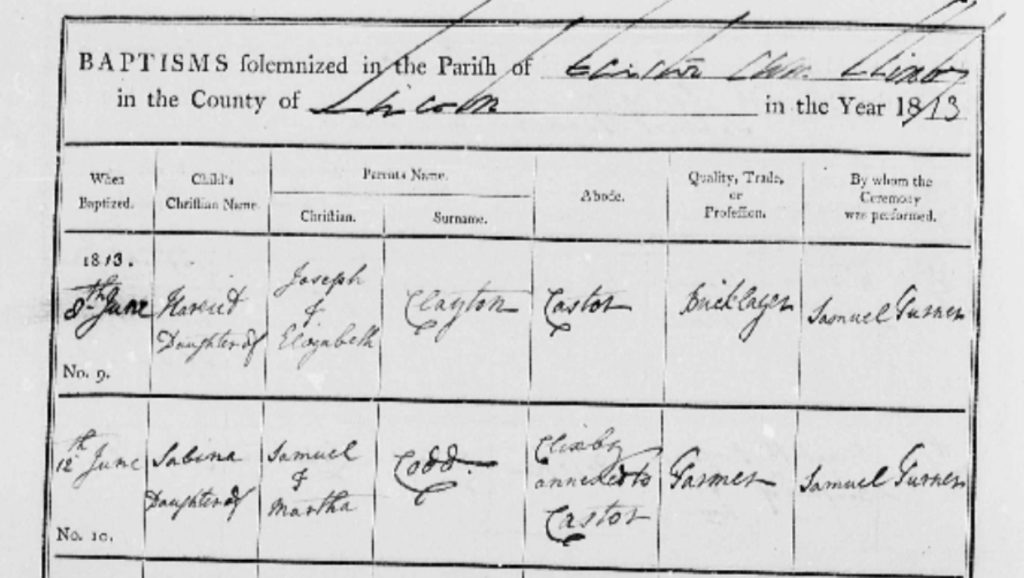

All Hallows’ is now a redundant church. It dates from the 13th century with additions and alterations during the following century. It deteriorated until only the chancel had survived by 1871. It was restored in 1889 by Hodgson Fowler but declared redundant in 1973.56
You may wonder where the name Sabina comes from and why she was given this name rather than the usual Mary, Elizabeth, Martha, Sarah or Ann, the most common names of that period. Or not given the names of her mother or grandmother as was the common practice during that time. One possible explanation could be this. The Winn family from Nostrell Priory in Yorkshire was a large landed family, who also owned land in the Thornton Curtis, Appleby and Frodingham areas of Lincolnshire. In 1761, Sir Rowland Winn married a wealthy Swiss heiress, Sabine d’Hervart and perhaps Martha and Samuel thought this was an unusual and individual name for their eldest daughter. Martha grew up in the area near Frodingham and, no doubt, would have heard of the Anglicised name of Sabine. There is a photo of Sir Rowland and Sabine on the Nostrell Priory website.
Marriage and Family
John married Sabina Codd on 16 May, 1835 at the Church of England in Drypool, Yorkshire6. Drypool is a parish in Kingston-upon-Hull, which was a major town across the Humber river just north of Barton and Horkstow.
NOTE: There are several trees on different websites which have John marrying a Sabina Dales who was also born in Caistor in 1812. As the church registers do not give the parents names, it is hard to know which is the correct Sabina. Also when you look in the censuses you will only see Sabina Johnson born in Caistor. However, I was able to verify that I had the correct Sabina (Codd) because on her son George‘s death certificate from Australia, it is listed that his mother was Sabina Codd.
Between 1835 and 1841, John and Sabina had three children. The older two, Ann and Samuel, were born in Ferriby Sluice and christened at the St. Nicholas Church of England, South Ferriby. Ann on 28 February, 1836 and Samuel on 17 September, 18377.
South Ferriby is located on the south bank of the River Humber at the northern ends of the Lincolnshire wolds. Since before the Doomsday Book (1086), South Ferriby has been the site of a ferry crossing between the north and south banks of the River Humber. A number of springs in and around South Ferriby meant that the village was one of the first in the country to have its own piped water supply.
To the west of the village is the hamlet of Ferriby Sluice where the Ancholme River meets the Humber. It was locally known as one of the ‘Low Villages’, nestling at the bottom of a chalk escarpment, where the chalk meet the clay to give a plentiful water supply.
Their next child, George, was born in Barton and christened at St. Peter’s Church of England on 20 October, 183989. A description of St. Peter’s Church is given in John Stephenson and Mary Gautby’s story.
St. Mary’s and St. Peter’s Church of England, Barton.
There were two Churches of England (Anglican) in Barton – St. Mary’s and St. Peter’s – both within several hundred metres of each other. This may seem strange but I’ll explain why.
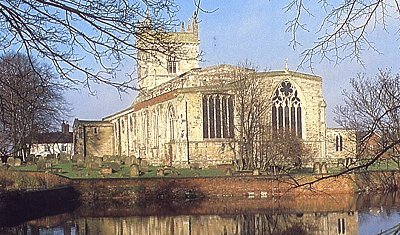
“St. Mary’s (previously known as Chapel of All Saints) was probably built of timber during the seventh century. It has undergone many changes throughout the centuries. St. Mary’s was always a church for the people.
“The earliest building on the present site dates to the 11th century, of which only the lower part of the tower and the north aisle arcade survive. The majority of the building is in the Early English Style with windows dating from the 14th and 15th centuries and window glass assembled in the 17th century. The porch was restored in 1938.”9
St. Peter’s, when first built during the 10th century, was in effect the Lord of the Manor’s private chapel. It was a building of prestige, where the Lord of the Manor could worship with his family and other noble people who would be there at his invitation. It had a small sanctuary, a small private baptistry and a very limited accommodation in the tower nave.
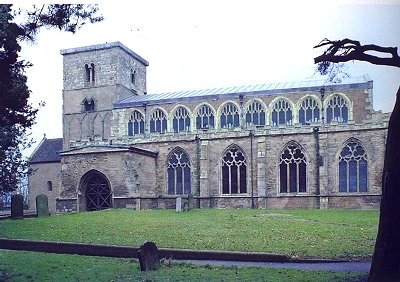
In 1115, St. Peter’s became a Monastic church ruled and governed by the successive Abbots until the dissolution of the Abbey in 1538 (during the rule of King Henry VIII). The people’s reaction to this granting away of the Church was to continue to maintain for themselves a Church of their own, St. Mary’s, providing their own Chaplains and priests totally independent of the Monastery.
By the 18th and 19th centuries, the Churches were both being used by the people of Barton until St. Peter’s was closed in 1970. It is one of the most architecturally important churches in the north of England and was excavated between 1978 and 1985, with some graves and artefacts dating back 1000 years. St Mary’s became the worshipping Church of England for Barton after this closure.
1841- 1851
By 1841, John and Sabina with their three children were living in Worlaby in Lincolnshire. Worlaby is about eight kilometres south of Ferriby Sluice and had a population of 426 persons in 1841. John was an agricultural labourer working on the farms surrounding the village.
John and Sabina stayed at Worlaby for a few years and, after a short time back in Ferriby Sluice, settled in Horkstow. We know this as their next three children Charles, Elizabeth and Joseph were born in Worlaby and then John was born in Ferriby Sluice in 1847, according to the 1851 census. The family then settled at 31 High Street in Horkstow, which is about three kilometres south of Ferriby Sluice and five kilometres north of Worlaby, and John had changed occupations to a coal porter. They had also had a young daughter, Sarah Ann newly born and christened in Horkstow. The 1851 census for Horkstow lists the population as 251 people.
1861-1891
John and Sabina continued living in Horkstow for the next ten years, having another three children, Mary, Emily and Thomas. By 1861 John, now aged 53 years, is back being and agricultural labourer, along with his son George, who was now 21 years old. The other two boys, Joseph and John are listed as agricultural servants. The difference between an agricultural labourer and an agricultural servant was that the labourer was hired usually be the week or day while the servant was often hired on contract for longer periods or a year and often lived on the farms themselves. Obviously the younger two boys, although they were servants, could still live at home. The younger children were scholars and Ann, Samuel and Charles had all left home.
Ann has probably married by now as she would be 25 years old. Samuel, at age 22, was living in Appleby in the house of Thomas Addison, who was a wheelwright. Samuel was listed as a journeyman-wheelwright. A wheelwright is a person who makes wheels for carts etc. And the ‘journeyman’ part meant he had mastered his craft and was no longer an apprentice bound to serve for a number of years. Journeymen were often hired day to day or on contract or could be self-employed. This meant he was a skilled labourer employed by a master craftsman but not able to set up his own business. All in all, John and Sabina had eleven children.
Interestingly, John and Sabina were living next door to Thomas Jacklin, aged 70 years and his wife Mary. Thomas is a farmer who owns 18 acres of land. Thomas is the brother of Sarah Jacklin, who married John Coupland. Sarah and John Coupland were the grand-parents of George Johnson’s future wife. So that makes Thomas and Mary (the next-door neighbours), George’s future great uncle and aunt-in-law.
John Johnson died in November,1862 and was buried In Horkstow on the 23rd of that month. He was aged 55 years. Sabina continued living in the same cottage in Horkstow until at least 1881. In 1871, Sabina, now aged 59 years, still had Joseph, Emily and Thomas living with her. They were all farm labourers. And by 1881, only the youngest Thomas is still with her in the cottage. The Jacklins were still living next door but Thomas died in 1885 aged 94 years.
1891
in 1891, Sabina, aged 80, is listed on two census’. The first is with her daughter Elizabeth at 13 Edward Street, Clee with Weelsby. Elizabeth had married Thomas Leary back in 1877. They had six children and Thomas was a general labourer. Sabina is also listed with her other daughter Emily Smethurst at 119 Guildford Street, Clee with Weelsby. These 2 premises are about 4 blocks from each other. Clee with Weelsby was originally a small shipping village about 2.4 kilometres South-East of Great Grimsby. It was absorbed into Grimsby during the 1880’s. Grimsby was a large town and seaport on the South Bank of the Humber Estuary close to where it reaches the North Sea.
Probably the reason Sabina is on both census is she was visiting Emily, where she is listed as a visitor. However, on the census for Elizabeth’s home, Sabina is listed as the mother-in-law, so most likely she was staying with Elizabeth. The 1891 Census was taken on Sunday 5 April.
Sabina was obviously being looked after by her daughters as she died about a month later on 1 May, 1891 from influenza and bronchitis. She had been living with her daughter Elizabeth at 13 Edward Street, Grimsby. Elizabeth made her mark on the death certificate. Sabina was 80 years old.

Children
The last reference I could find for Ann was in the 1851 census when she was fifteen years old. By the next census in 1861, Ann was probably married.
George had married Eliza Coupland and their story is told here.
Meanwhile, Charles had married Fanny Croft in 1868, and by 1871 was an agricultural labourer with a young daughter Sarah living in Saxby, Lincolnshire. By 1881 Charles had risen in the world and was a farm bailiff or farm manager. The family had moved to 59 Sandtoft Road, Belton, about 50 kilometres away. From 1881 to 1901, Charles continued working on the land, moving to Elsham and then to Alkborough where he eventually owned his own land. Charles and Fanny ended up having six children and continued living on their farm in Alkborough for the rest of their lives. Fanny died in June, 1918 and Charles followed not long after in September, 1918.
As we know, Elizabeth was mentioned above with her mother in the 1891 census, had married Thomas Leary. They had at least six children. Thomas was a general labourer and died in April 1903. Elizabeth survived until September, 1930.
Joseph married Louisa Clarke in December, 1877 at Keelby, Lincolnshire. The had four children and lived in Ashby Village during the 1880’s. Ashby Village was on the outskirts of Scunthorpe. Joseph was a publican at this time. By 1891, Joseph had changed occupations and become a cattle-dealer and had shifted to the town of Winterton. Winterton is about 8 kilometres north-east of Scunthorpe and was noted as a cattle and market town. Harold, his eldest son became a butcher in Winterton. I do not have any death date for Joseph.
John, 7th child of John and Sabina, married Martha Elizabeth Codd, his cousin. She was the daughter of his mother Sabina’s brother Samuel and Hannah Whatham. John was about ten years older than Martha. They had one child and John was a labourer for most of his life. He worked in Lancashire in Ashton-under-Lyne and Warrington before moving back to Alkborough in Lincolnshire. John died in December, 1918.
Sarah Ann married Frederick Rowbotham in May, 1872 in Horkstow. Frederick was a bricklayer at the time. They had nine children. The family moved around from Horkstow to Grimsby (1881) and then to Cheetham, a small village which became a suburb of Manchester in Lancashire. By 1901 the family had shifted to 135 St Clowes Street, Broughton in Lancashire. Frederick died on 2 July, 1903. Sarah continued living in Broughton but had shifted to 107 Great Cheetham Street West. Sarah died on 4 January, 1921 aged 70 years, at Barton upon Irwell in Lancashire.
Mary, the ninth child, married Edward Woods at Horkstow on 14 May, 1874101. They moved to Hull in Yorkshire, but sadly, their marriage was short-lived as Mary died presumably in childbirth or from childbirth and was buried on 7 March, 1875 with her baby daughter Annie Elizabeth.

Emily had married William Smethurst in 1882 and had had three children. I could not find William Smethurst in the 1891 census but perhaps he was at sea as his profession was seaman. Emily and William had four children. William continued being a seaman for several years but obviously retired from the sea as he was a tobacconist and newsagent in 1911. Sadly, he died at the age of 55 years on 21 August, 1911 and was buried at All Saints, Grimsby. Emily continued living in Grimsby, finally dying on 18 August, 1935 at the age of 81 years.
Thomas, the youngest child, married Sarah Ann Wrack in Brothertoft in Lincolnshire on 25 October, 1887. From the census of 1901 and 1911, Thomas and Sarah Ann continued living in Horkstow where Thomas was an agricultural labourer. They had at least seven children. There is a death for a Thomas Johnson in December 1920 and I believe this is our Thomas. However, this would need to be verified properly by a death certificate.
- IGI – Christening. Batch C030141.
- https://britishlistedbuildings.co.uk/
- www.marshchapel-village.co.uk/
- https://www.geograph.org.uk/photo/104793
- http://en.wikipedia.org/wiki/All_Hallows_Church,_Clixby
- IGI – Marriage. Batch M010702.
- IGI – Christening. Batch C031501.
- IGI – Christening. Batch C026902.
- https://en.wikipedia.org/wiki/St_Mary%27s_Church,_Barton-upon-Humber
- England, Select Marriages, 1538-1973
